Welcome to the ultimate guide on how to build the perfect home theater speaker system! There’s nothing quite like a high-quality movie-watching experience in your own home. Really immersing yourself in quality audio that transports you into action means building a proper home theater system. With so many types of speakers, brands, and features to choose from, it can all seem a little stressful. That’s where we come in.
In this article, we’ll provide you with all the information you need to make an informed decision on which home theater speakers and equipment make the most sense for you. Let’s elevate your in-home entertainment experience!
Table of Contents
Key Steps To Planning Your Home Theater Speaker System
When initially planning your purchase of speakers for your home theater, it can quickly get overwhelming. That’s why it’s important to think clearly about all the key steps before you make your choice. For the ideal sound experience, you’ll first want to plan your budget. This will greatly impact how the type of home theater speakers and equipment you buy. Larger home theater setups equal more individual speakers, more power, and more cables.
Your budget will dictate the type of speaker configuration you want. Then consider how you will power and place the speakers in your home theater. Both underpowered speakers and bad placement can result in a disappointing audio experience. Taking time to think ahead will make you a more informed buyer. It will also make help in maximizing the sound quality of your home theater system.
How To Budget For Audio in Your Home Theater

Building a sound system for a home theater isn’t cheap. Setting your budget ahead of time goes a long way in identifying exactly the type of speaker system you can afford. That includes everything from how many speakers to how premium your audio equipment will be. The baseline cost for home theater speakers is around $100 to $200 for a pair of active speakers that don’t require a receiver. At the top end of budgets, we’re talking thousands of dollars for multi-channel surround sound systems. For the sake of this article, we’ll assume these estimates are for entry-level and mid-range equipment.
Stereo speakers can be bookshelf or floorstanding speakers. Bookshelf speakers are more cost-effective and the better overall option for most situations. Using those parameters, below are the normal prices ranges you can expect for key pieces of home theater equipment.
Estimating Cost For Home Theater Equipment
- Stereo Speakers – $100 to $800
- Center Speaker – $100 to $300
- Home Theater Receiver – $300 to $1,200
- Subwoofer – $150 to $500
- Pair of Surround Speakers – $50 to $300
- Pair of Dolby Atmos Speakers – $50 to $300
How To Spend Wisely When Buying Your Speaker System
These price ranges are a little flexible and budget options for some equipment come with fewer drawbacks (more on this later). How does this help with constructing your home theater speaker system? With these estimates, you can begin to guess how much money you will spend on your desired setup. For a 3.1 sound system, you’re looking at a prospective budget of around $650 to $2,000. Will you be purchasing entry-level options across the board or aim for better audio quality with certain speakers?
Upgrading and buying other speakers is a key part of buying home theater speakers. A great subwoofer will always be a great subwoofer. By comparison, a budget pair of bookshelf speakers may be serviceable in your 3.1 system now. They can later serve as good pair of dedicated surround speakers when you buy more speakers.
Where Should I Spend The Most Money On?
For all the aforementioned reasons, it’s sometimes smart to spend more on a subwoofer, center speaker, or AV receiver. Especially if you know you eventually want to build a larger surround sound system. The speakers in our living room now might later end up in your dedicated theater room. It should also be noted that the price range of a home theater AV receiver differs from the other items here. 300 dollars is the entry-level marker for a 5.2 receiver like the Sony STRDH590. It might make sense to pay for a larger receiver now if your plan is to upgrade in the future.
How To Pick The Best Speaker Configuration For Your Home Theater
The configuration of your home theater speakers should be dictated by your budget, desired experience, and the limitations of the space. Everyone loves the idea of the ultimate 13-speaker Dolby Atmos surround system for the most immersive sound. But if you have limited floor space, it might be a non-starter. You’ll also have to consider your listening position and any foreseeable issues with setup or installation. We’ll discuss the good and bad of many popular speaker configurations below.
Understanding Speaker Configurations
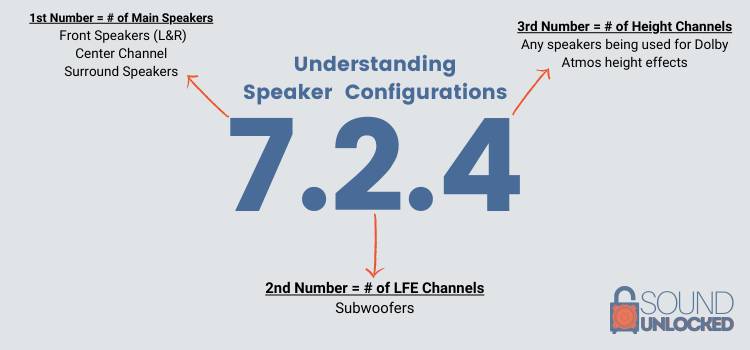
A speaker configuration simply states exactly how many channels or speakers are in your home theater system. The first number is the number of channels the speaker system has when including your three front speakers or LCR (left, center, right) and other traditional surround channels. The second number in the configuration is the number of subwoofers for LFE or Low-Frequency Effects channels. Lastly, the third number is the amount of dedicated Dolby Atmos channels for height effects. A 7.2.2 home theater system would have seven speakers (LCR and four surrounds), two subwoofers, and two Atmos speakers.
Every passive speaker in your system will need to be connected to your AV receiver. While most subwoofers don’t require external power, they must still connect to your AVR. A subwoofer pre-out is the best option, but not all receivers have one. Make sure to account for your configuration to buy a receiver capable of powering and connecting to all your speakers.
2.0 vs 2.1 vs 3.1: Basic Speaker Setups
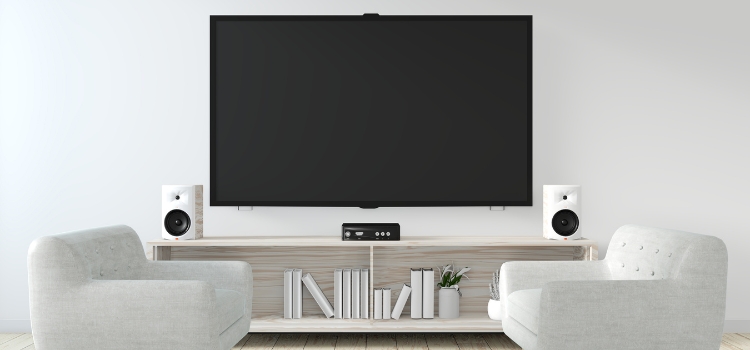
Smaller home theater setups make sense for buyers with limited space like a bedroom or living room. In these situations, the power needed to achieve loud volumes might not be necessary. Active speakers become a reasonable solution. Installation and setup can also be much easier with wireless speakers. While these speaker configurations won’t achieve the most immersive surround sound audio experience, they can outperform TV speakers and sound bars.
Cost of Small Home Theater Speaker System
You can find a realistic budget range for each of these configurations in the below table. Entry-level amounts for 2.0 and 2.1 configurations do not account for receiver costs. They won’t be required for those if you opt for active speakers. Active speakers don’t require external power. Many models of active speakers can also connect via RCA, optical, Bluetooth, and more. I would not recommend active speakers for those with any plans on having a larger system in the future.
| Configuration | Entry-Level | Mid-Range | Equipment |
| 2.0 | $100 | $800 | LR and AVR (optional) |
| 2.1 | $300 | $1,300 | LR, Sub, and AVR (optional) |
| 3.1 | $650 | $1,600 | LCR, Sub, and AVR |
Selecting the Right Speaker Configuration
The main differences between these three speaker configurations are low-frequency production and clarity of dialogue. A 2.0 or stereo setup with quality bookshelf speakers can get loud enough for some small and medium rooms. What will be lost is true low-frequency production and deep bass. Bookshelf speakers typically have a frequency response that bottoms out around 45Hz. That’s far from the booming sub-bass some subwoofers can manage. These are often the powerful bass notes that bring movie soundtracks to life during explosions. 2.1 home theater systems add that much-needed low-end thump.
A 3.1 speaker configuration is another expansion that adds a center channel speaker. Thought by some to be the most important speaker in a home theater, the center channel speaker handles the majority of the dialogue. In a 3.1 speaker configuration, voice dialog in movies and TV shows will be clearer and easier to hear. This allows bookshelf speakers to focus on reproducing other sound effects. The result is an improvement in overall clarity, separation, and sound quality.
5.1 vs 7.1: Surround Sound Home Theater System
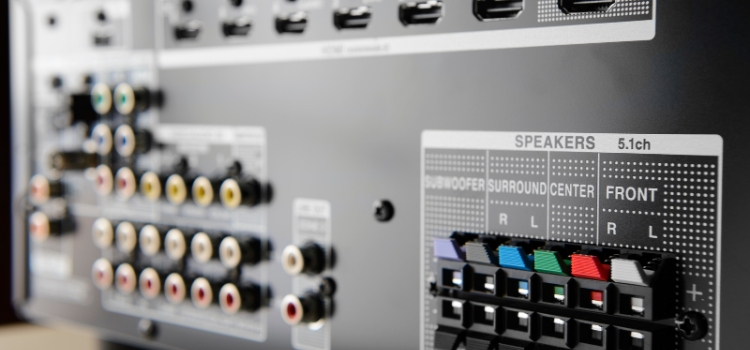
5.1 and 7.1 surround sound configurations are both popular for immersive sound in home theaters. The key difference between these two options is the surround speakers being used. While a 5.1 surround sound setup has two dedicated surround speakers, a 7.1 configuration has four. A 5.1 speaker configuration would have two side surrounds. The addition of rear surround speakers makes it a 7.1 speaker configuration.
Cost of A Surround Sound Speaker System
The below table includes a budget comparison for 5.1 and 7.1 speaker configurations.
| Configuration | Entry-Level | Mid-Range | Equipment |
| 5.1 | $700 | $2,300 | LCR, Sub, Surrounds (2) and AVR |
| 7.1 | $950 | $2,800 | LCR, Sub, Surrounds (4) and AVR |
Cost is a key factor when deciding between these two configurations. A 7.1 system is generally more expensive due to the additional two speakers required for surround sound. It’s not always just the cost to buy the speakers though. While many budget shoppers may opt for a 5-channel receiver, that’s not enough to power a 7.1 system. Opting for a 7.2 AVR or larger makes options less than $500 a little harder to find.
Picking The Best Surround Sound System For Your Space
How can the jump to 7.1 add to a surround sound system? A 7.1 system adds two rear surround sound speakers to the mix. These rear channels pair with the side surrounds to create a more accurate and realistic soundstage, as sound is coming from extra channels. While this adds to the immersion experienced during movies, it’s still building on something the 5.1 already has.
Some people actually opt for 5.1.2 over a 7.1 system. This instead adds two Dolby Atmos speakers instead of two rear speakers. We’ll cover Dolby Atmos in more detail later, but it’s important to mention it now for another reason.
5.1.2 speaker systems don’t necessarily require additional floor space, unlike the move to 7.1. Finding a place to position two surround sound speakers in many rooms can already be a struggle. A 5.1 speaker configuration can often be the sweet spot for form and function. It stops just short of requiring additional components that require additional money and floor space.
7.2.2 vs 5.2.4: Dolby Atmos Home Theater System
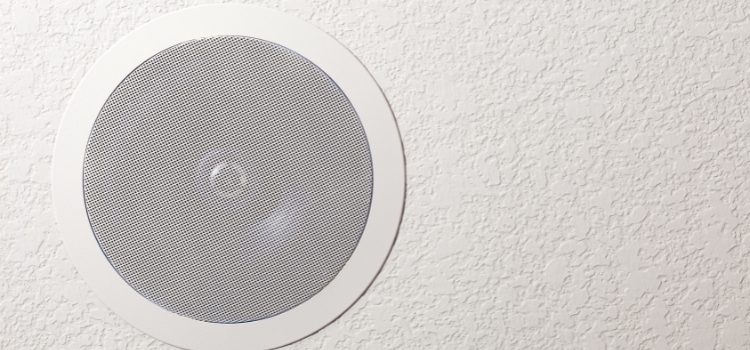
With this comparison, we’re into more expansive sound systems that comprise eleven home theater speakers. That includes a Dolby Atmos surround system experience that requires a significant investment. In the below table, you’ll find a cost and equipment comparison for these two surround sound system configurations.
Estimating Budget For Dolby Atmos Sound System
| Configuration | Entry-Level | Mid-Range | Equipment |
| 7.2.2 | $1400 | $4,200 | LCR, Sub (2), Surrounds (4), Atmos (2), and AVR |
| 5.2.4 | $1400 | $4,200 | LCR, Sub (2), Surrounds (2), Atmos (4), and AVR |
The pricing is similar because the actual layout of your home theater speakers is the main difference here. A 7.2.2 sound system includes your left speaker, center speaker, right speaker, two subwoofers, two side surrounds, two rear surrounds, and two Dolby Atmos height speakers. A 5.2.4 system simply trades two rear surrounds for two more Dolby Atmos speakers. While specialty Dolby Atmos speakers are available, bookshelf speakers can be used for both traditional surrounds and Dolby Atmos.
A 9.2 home theater receiver will be required to power the nine speakers in each of these configurations. The receiver’s settings can then be modified to set up a 7.2.2 or 5.2.4 speaker configuration. A new 9.2 AV receiver will start around $1,000 on sale and can easily exceed $1,500.
Choosing The Right Dolby Atmos Configuration
The layout and shape of your room should be the first consideration in deciding between 7.2.2 and 5.2.4 speaker systems. The four surround channels in a 7.2.2 configuration include two side surround and two rear channels. Those rear channel speakers should be at least a few feet behind your listening position.
Room layouts that require you to mount rear speakers directly behind will result in less separation of the side and rear surround speakers. A 5.2.4 configuration with two additional height channels may be preferable in this instance. Four height channels will add another layer of depth to your Dolby Atmos sound effects.
If you opt for in-ceiling speakers, there will of course be additional installation concerns that you should factor for. Still not sure? Luckily, you can simply test out both configurations yourself. Pop in your favorite Dolby Atmos movie soundtrack and do a trial run with both configurations. Your preference may surprise you, as well as be dependent on the shape of your specific room. Home theater is never one size fits all.
How To Choose Your Front Speakers: Bookshelf or Floorstanding
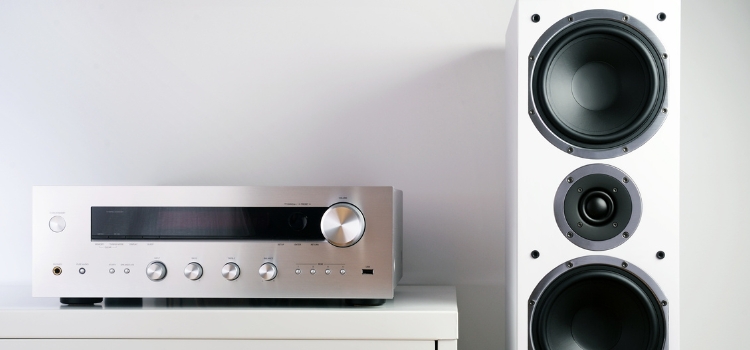
Choosing the right stereo speakers for your LCR is a balancing act. Not only are these speakers important for sound quality. It’s popular to match your stereo speakers with a center channel and surround speakers from the same brand. The stereo speakers in a home theater system are typically floor-standing speakers or bookshelf speakers. While both are stereo speakers, they differ in a few ways. Bookshelf speakers are the more logical choice for most users. They are smaller speakers compared to floor-standing or tower speakers.
Key Differences: Drivers, Size, & Frequency
A typical bookshelf speaker has two drivers. A tweeter that reproduces higher frequencies and a woofer for midrange and lower frequencies. The frequency response of the average bookshelf speaker is around 50Hz to 20kHz. By comparison, the larger cabinet of floor-standing speakers can house more drivers. While driver configurations vary, floor-standing speakers often have a tweeter and multiple woofers. Some even have dedicated woofers for midrange or bass.
Larger cabinets and additional drivers give floor-standing speakers a few advantages. They are better for room-filling sound and can produce deeper bass. While a few floor-standing speakers can reach close to 30Hz, they aren’t a replacement for an actual subwoofer. You’ll always need a subwoofer for truly impactful home theater bass.
Why Bookshelf Speakers Are Usually Ideal
So why are bookshelf speakers still the best choice for most people? Bookshelf speakers come in small and larger form factors. And many have the power handling to project to even large rooms. You’ll also get the most for your money when it comes to purchasing bookshelf speakers. Bookshelf speakers and tower speakers from the same brand often use drivers of similar quality. It often doesn’t make sense to spend more money on larger tower speakers.
Lastly, placement and setup are much easier with bookshelf speakers. They can be placed on the furniture, placed on stands, or even mounted. Want to upgrade? You can easily use them as surround channels with flexible placement options.
Selecting The Best Home Theater Subwoofer For Your Room
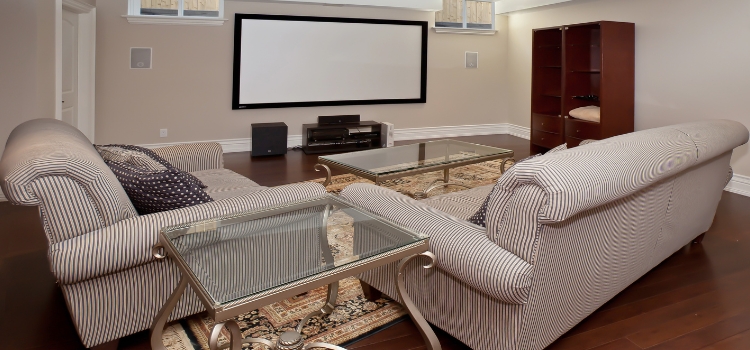
Monstrous and impactful bass is a standout feature in the best home theater systems. And this is an experience only a subwoofer can deliver. When planning your speaker system, the subwoofer is somewhere you shouldn’t cut corners. Subwoofers come in various sizes with 12-inch subs being the sweet spot of size and performance. Your room size should dictate exactly how large of a subwoofer you need. A 10-inch subwoofer might be enough for a small room. For larger rooms, a 12 or 15-inch subwoofer might make more sense. Multiple subwoofers should also be considered for larger spaces.
Ported subwoofers are ideal for home theater, as they are great for booming and deep bass. Sealed subwoofers generally have a tight and more controlled bass response. Large cabinets and powerful amplifiers are what allow subwoofers to the necessary air to produce low-frequency sounds. A 10-inch subwoofer with 200 peak Watts may be enough for some. But it won’t produce bass as impactful as a 15-inch subwoofer with 800 peak Watts. A subwoofer’s frequency response specifies what frequencies it can produce.
How Low Can You Go? Subs & Frequency Response
When it comes to subwoofers, the lower the better. Many subwoofers of various sizes can reach to 30Hz and below. Larger, more powerful subwoofers are also more capable of lower frequencies. More premium subwoofers ($500-$1,000) can reach sub-20Hz levels. Those are sub-bass frequencies that can be heard and felt. These extremely low frequencies really add to the excitement and intensity of the movie-watching experience. Solid budget options do exist for subwoofers. Unfortunately, they typically fall short in regard to frequency response, power, or clean bass. It sometimes makes sense to stretch your budget a little on a subwoofer compared to other speakers.
How To Choose The Right Center Channel Speaker
One of the more underrated home theater speakers is the center channel. Center speakers are responsible for almost all of the dialogue, but are too often an afterthought. Have you ever watched TV late at night and had to lower the volume? Then turned it back up when you couldn’t hear someone’s voice? It’s actually a common problem with dialogue in modern mixes.
A quality center channel speaker will greatly assist in avoiding these types of issues. It will improve overall sound quality including greater separation of dialogue and sound effects. An AV receiver can also separately increase the volume of your center channel.
Listening position and room composition can make a quality center channel more important. Larger rooms where the listener is far from the center channel will make clear dialogue more difficult. A listening position that isn’t directly in front of your center channel can also cause problems.
An off-axis or wide listening position is something traditional MTM (midrange, tweeter, midrange) center speakers struggle with. If that sounds like your room layout, you might want to target a 3-way center with 4 drivers like the NHT C-LCR. They generally get wider coverage and dispersion without having to worry about dead spots.
Speaker Matching & Center Channels
Speaker matching, size, and power are three additional things to consider when choosing a center channel. It’s common practice to match your center channel with your left and right speakers. This means if you purchased the ELAC 2.0 B6.2 bookshelf speakers, you would also purchase the center channel from the same speaker series from ELAC. The thinking is that similarly designed speakers will have matching timbre and sound signatures. While this is a good practice, it’s unfortunately not always easy to execute.
How To Choose Speakers For Immersive Surround Sound
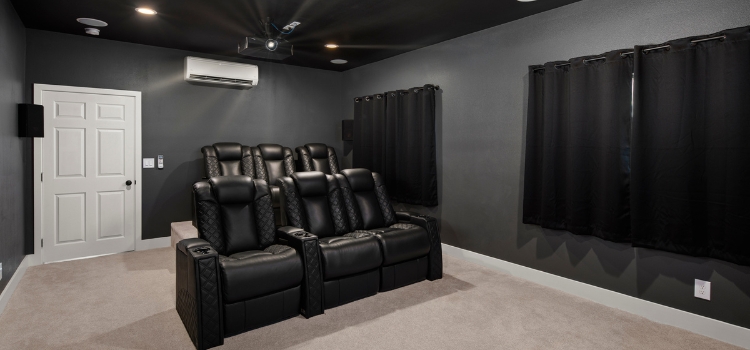
While finding quality surround sound speakers for your home theater is important, it doesn’t need to be difficult. Buying surround sound speakers often results in unnecessary confusion for several reasons. Shoppers tend to think they need a specific type of speaker for proper surround sound. Truthfully, shoppers do have some flexibility. For traditional surround sound (side surrounds and rear surrounds), the bookshelf speakers many would use for your front speakers work great. This is why people often start with budget bookshelf speakers. Those same speakers can be used for surround sound in the future. Floor-standing can even be used for surround sound, although their size often makes this a non-starter for many.
Surround Sound Speakers & Limited Space
That leads us to another reason speakers for surround sound require flexibility. Space limitations can make smaller speakers with more placement options a necessity. The result is more people opting for in-wall speakers, wall-mounted speakers, or niche form factors. The Polk OWM3 is a great example. Its slimmer form factor allows it to be wall or ceiling-mounted more easily. But they won’t deliver the same sound quality as a full-sized bookshelf speaker.
Unless you have space limitations, bookshelf speakers are the best option. Rear and side surrounds won’t have as much of a workload as your front speakers. Outside of larger rooms, smaller bookshelf speakers with 4″ woofers will work well and are more affordable.
Choosing Dolby Atmos Speakers
Finding speakers for a Dolby Atmos system is a similar story. Contrary to popular belief, you don’t need ceiling speakers for Dolby Atmos. You can even use bookshelf speakers as long as you have an Atmos-compatible AVR. Unfortunately, Atmos speakers require placement above listener level and preferably the ceiling. This makes smaller speakers ideal.
For sound quality and immersion, ceiling speakers will provide the best experience. This can really add to install and setup costs though. Other popular options include ceiling or wall-mounted speakers and up-firing speakers specialized for Dolby Atmos.
Buying The AV Receiver For Your Home Theater Speakers
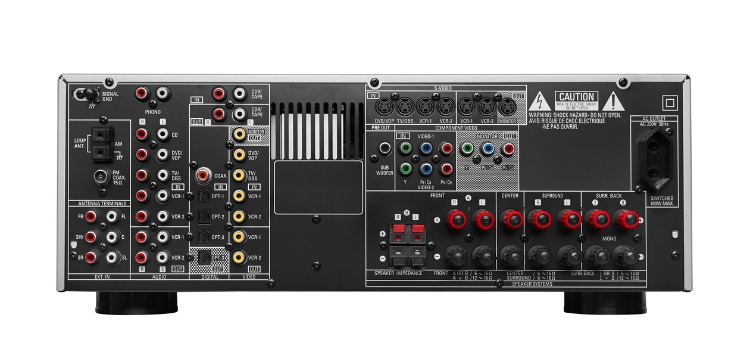
Many spend a lot of time researching all the different speaker options before thinking about home theater receivers. The AV receiver is the brains of your home theater speaker system. It powers your speakers in addition to sending them an audio signal. This includes processing the immersive audio and surround sound formats people love. Your AV receiver along with media streaming devices dictate compatibility for things such as 4K, HDR, and media. For this article, we won’t cover all the features of an AV receiver. We’ll mostly focus on a few key considerations when it comes setup of your receiver and speakers.
Passive Speakers Vs Active Speakers
When discussing home theater speakers, they’re typically referring to passive speakers. Passive or wired speakers have binding posts for connecting speaker wires. Those speaker wires will also connect to your AV receiver, which delivers power and an audio signal to your passive speakers. Unlike passive speakers, active speakers don’t require power from an external amplifier. Active or Wireless speakers have an integrated amplifier and can simply be plugged in for power.
Connecting Speakers With Receiver Pre-Out
Connecting your active speakers to home theater receivers will require extra steps. You’ll need an AV receiver with pre-outs. This shouldn’t be confused with a subwoofer pre-out, which is common for connecting active subwoofers. Affordable and budget AVRs often don’t include pre-outs. Pre-outs facilitate a connection from your receiver to your active speakers via an RCA cable. This allows your receiver to send an audio signal to your active speakers.
There are multiple use cases for using receiver pre-outs. Let’s say you have a 7.2 receiver that can power seven speakers. A 7.2 receiver with two additional pre-outs may be capable of running a 9.2 speaker configuration. Or some users may simply want to use five passive speakers and two active speakers. Some may even utilize a 9.2 AVR, 11 passive speakers, and an external amplifier for an 11.2 home theater system People are often tempted by the idea of wireless surround speakers.
Possible Issues Using Active Speakers
While mixing passive and active speakers is possible, it’s not always ideal. There are several potential problems (interference, volume regulation, etc) and an RCA cable and power cables aren’t exactly wireless. It’s extremely important to do extensive research on specs and compatibility before buying a home theater AV receiver. As an example, some 7.2 AVRs even have extra speaker pre-outs that can only be used for stereo audio. AVRs are expensive and complex devices. Doing research upfront will ensure it performs in line with your expectations.
Power Handling and Sensitivity
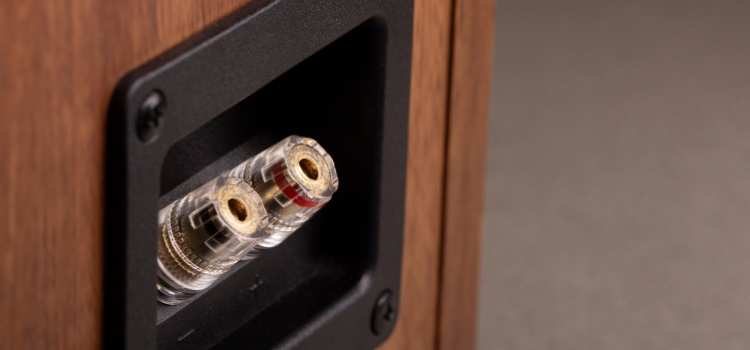
Many people obsess over power when researching AV receivers. While power is important, it’s rarely an AVR issue outside of larger home theater rooms. Focusing on buying the right speaker will be more beneficial if volume levels are a concern. Finding a speaker with good sensitivity and power handling will go a long way. Speaker sensitivity is a measurement of how sensitive a speaker is to power. Home theater speakers with good sensitivity will be more efficient at reaching loud volumes.
The average speaker sensitivity is around 87 dB. A speaker with a sensitivity of 90 dB is good, while under 85 dB would be considered inefficient. It doesn’t matter how much power your AVR delivers. A speaker with a sensitivity of 90 dB will play louder than a speaker with a lower sensitivity.
Do I Need The Most Powerful Speakers?
Good sensitivity does not equal good sound quality though. It’s simply a specification, as many high-end audiophile speakers are considered inefficient or power-hungry. Larger tower speakers are also a good option if room-filling sound is a priority. Tower speakers generally have high sensitivity than bookshelf speakers. Power handing is also another key specification for speaker volume. If you do plan on throwing a lot of power at a speaker, you want to check its power handling or max power.
In Conclusion: Planning Your Home Theater
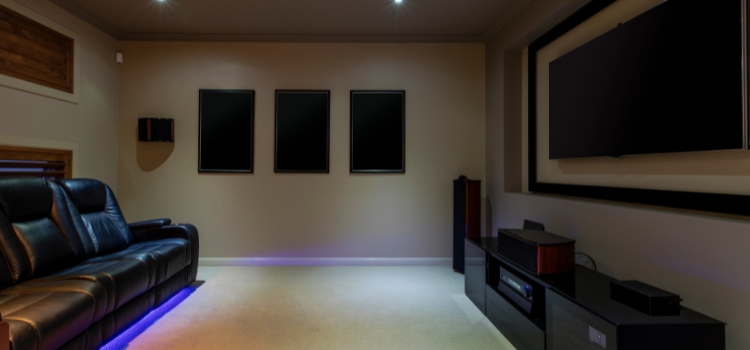
As you can see, a lot goes into the planning and set up of a quality home theater. This should provide a good foundation for those wondering how to choose a home theater system and set it up properly. It’s important to understand all the necessary steps and considerations before you buy home theater speakers. Issues like room limitations and speaker placement may dictate purchasing decisions and help you get the most for your money.
Additionally, it’s helpful to put a lot of thought into the type of system you want. It’s possible what you buy now can be upgraded into a larger system in the future. Not only will this save you money long term. It will save you the headache of having to sell or repurpose equipment you no longer need later.
FAQs: Building A Home Theater System
How Much Should I Spend On A Home Theater Speaker System?
There is no hard and fast room, as speaker prices and the size of your theater will vary. You could spend from $500 to $4,000+ between speakers and a receiver. A smaller speaker configuration and entry-level speakers will severely cut down on your total spending.
Do I Need Two Subwoofers In My Home Theater?
While two subwoofers are better than one, multiple subwoofers are not a requirement. One 12″ subwoofer may be sufficient for many. Having two subwoofers will make for a more even bass response with less distortion. This effect will be more evident for larger rooms.
How Many Watts Is A Good Home Theater System?
Wattage isn’t necessarily a great indicator of quality in a home theater system. Total wattage will typically depend on your home theater receiver and how many channels or speakers you have. While passive speakers may have a high power handling, they’ll very rarely max out in most home theater systems. If maximum volume is really a concern, just focus on speakers with high power handling (400W peak) and sensitivity.
How Many Speakers Do I Need For My Home Theater System?
This depends on your budget and how much space you have in your home theater room. While a 7.2.4 Dolby Atmos surround setup will provide an immersive experience, space is needed for proper speaker placement. You need to take into account your desired experience, budget, and any limitations of your space. This is the only way to figure out the ideal speaker layout for your specific scenario.

Keith Collins has been writing for over 15 years for various publications. He’s a lover of music, home theater, and excellent sound quality. His fondness for technology in addition to his non-stop curiosity fuels his writing ventures.